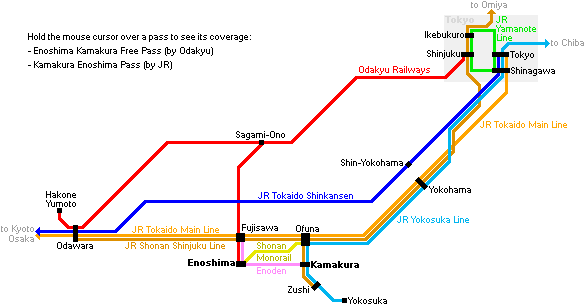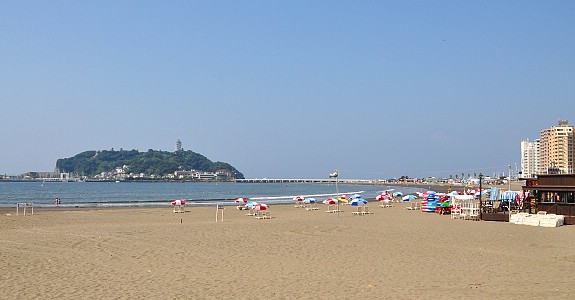
Only a short train ride west of Kamakura, Enoshima is a pleasantly touristy island just off coast but connected by bridge with the mainland. The island offers a variety of attractions, including a shrine, park, observation tower and caves. Views of Mount Fuji can be enjoyed on days with good visibility.
Enoshima is divided into a yacht harbor accessible to motorized traffic and a forested hill which can only be explored on foot (and paid escalators) and contains most of the sights. Several shrine buildings, collectively known asEnoshima Shrine, are found around the island and are dedicated to Benten, a popular goddess of good fortune, wealth, music and knowledge. Benten is believed to have created Enoshima before subduing a five headed dragon that had been terrorizing the area.
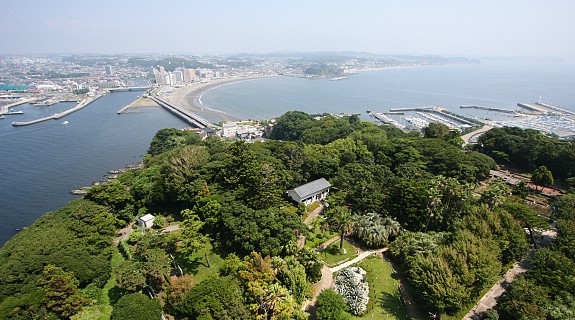
An interesting aquarium and some of the closest beaches to Tokyo are located on the mainland just off Enoshima. The beaches on either side of the island can become very crowded with sun bathers and swimmers during the summer holidays in July and August, while the long stretches of beach that continue to Chigasaki in the west and Kamakura in the east are popular surfing spots.
Visitors to Enoshima should consider purchasing the Enopass, a combination ticket that includes admission to the island's main attractions (garden, observation tower, caves) and use of the escalators for 1000 yen. The pass provides additional discounts on admission to the Benten Statue, the Enoshima Spa and the aquarium as well as on purchases at dedicated shops and restaurants. The Enopass can be purchased at tourist information desks and the escalator ticket office.
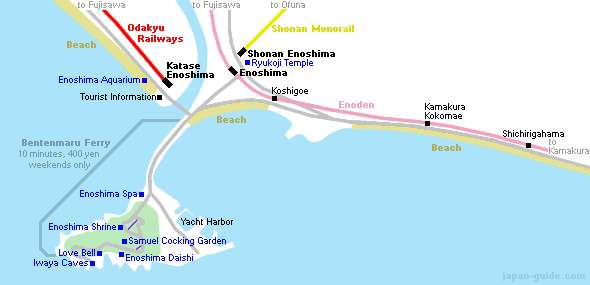
On Enoshima Island
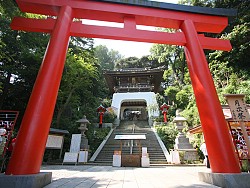 |
Enoshima Shrine  |
Hours: 8:30 to 17:00
Closed: No closing days
Admission: Free (150 yen to see the Benten statue) |
| Enoshima Shrine consists of three separate shrines that are located in different places around the island. The main complex includes an octagonal building that houses one of Japan's three most venerated statues of Benten, the patron goddess of Enoshima. Since Benten is also the goddess of wealth, some visitors will wash their money at the shrine's pond. |
|
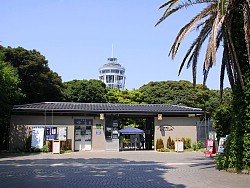 |
Samuel Cocking Garden  |
Hours: 9:00 to 18:00 (until 17:00 in winter; until 20:00 in summer)
Admission ends 30 minutes before closing
Closed: No closing days
Admission: 200 yen (garden), 500 yen (garden and observation tower) |
| A pleasant park with a 60 meter tall observation tower, that also serves as lighthouse, is built on the former site of the residence of Samuel Cocking, a British trader who purchased a considerable part of Enoshima in the late 19th century and built a botanical garden there. |
|
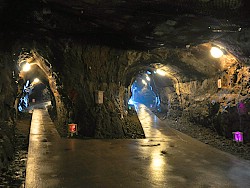 |
Iwaya Caves  |
Hours: 9:00 to 17:00 (until 16:00 from November to February)
Closed: No closing days (except when the weather is very bad)
Admission: 500 yen |
| Two touristy and easily walkable caves can be found in the cliffs along Enoshima's southern coast. The first cave contains some Buddhist statues, while the second cave is dedicated to the legendary dragon that used to terrorize the area. |
|
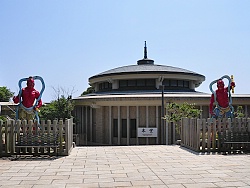 |
Enoshima Daishi  |
Hours: 9:00 to 18:00
Closed: No closing days
Admission: Free |
| When the government forcefully separated Shinto and Buddhismduring the Meiji Period, all three temples on Enoshima were destroyed and their land sold off. It was not until 1993 that a Buddhist temple returned to the island: Enoshima Daishi, a modern temple of the Shingon Sect, houses a six meter tall statue of Fudomyo, a protector of Buddhism. |
|
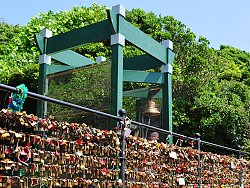 |
Love Bell  |
| At the end of a short side trail stands a bell on top of Enoshima's hill with nice views over the ocean. Due to a love related legend involving Benten and the dragon, couples ring the bell together and write their names on locks that they leave attached to the fence, similar to the wooden prayer plates (ema) left at shrines. |
|
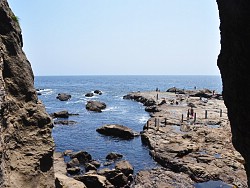 |
Southern Coast  |
| The southern coastline of Enoshima is made up of jagged cliffs that fall steeply towards the ocean below before they suddenly level out just at the waterline, forming wide stone plates where people gather during low tide to enjoy sunbathing and fishing. The Iwaya Caves are also found there, as well as the landing place of the small Bentenmaru boats that provide a connection to the mainland on weekends and holidays. |
|
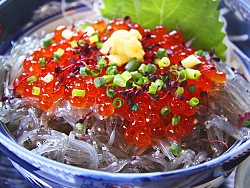 |
Shirasudon (Shirasu Donburi)  |
| Shirasu is the general term for young, white fish that measure only about a centimeter. They are caught in large numbers in Sagami Bay around Enoshima and enjoyed at local restaurants, where they are most popularly served raw or cooked over white rice as donburi. The photo to the left shows a variety of the dish where shirasu is served with salmon roe (ikura). |
|
On the mainland near Enoshima
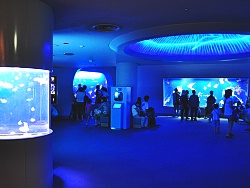 |
Enoshima Aquarium  |
Hours: 9:00 to 17:00 (from 10:00 from December to February)
Admission ends one hour before closing
Closed: No closing days
Admission: 2000 yen |
| The Enoshima Aquarium is a large, modern aquarium found along the beach across the bridge from Enoshima. Much of the aquarium, including its two story tall main tank, displays the diverse aquatic life found locally in Sagami Bay. The aquarium also has dolphin shows, penguins and seals and an excellent jellyfish display. |
|
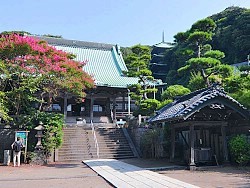 |
Ryukoji Temple  |
| Ryukoji Temple was built on the site where Nichiren, founder of the Nichiren Sect of Buddhism, was almost executed. According to the legend, a timely flash of light and thunderclap convinced the executioner to abandon his task. Visitors to the temple can see the large main hall, the cave where Nichiren was imprisoned, a white stupa and a five storied pagoda that was added during the Meiji Period. |
|
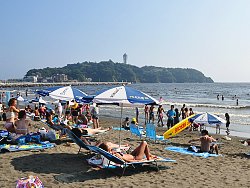 |
Beaches  |
| Beaches line the entire coast to the right and left of Enoshima. Directly next to Enoshima are two popular swimming beaches which are patrolled by lifeguards and lined by restaurants and shaded rest houses that play popular music and rent deck chairs and parasols to beach goers during the summer holidays. Further away, the beaches are also popular surfing spots. |
|
|













